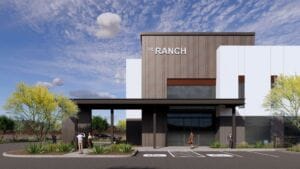With more than 20-years of experience in architecture, Caroline Lobo, president of American Institute of Architects Arizona, brings a unique perspective and a wealth of experience to AIA in its efforts to promote the architectural profession through the strength and participation of members.

In addition to her role as president, Lobo is also the founding principal at suoLL architects, where she focuses on design and sustainability.
Born and raised in Mumbai, India, she has worked on a number of residential, institutional, healthcare and educational projects across the globe in Germany, India, and the United States.
Her work with different cultures gives her a unique perspective and understanding of needs based on cultural variables, which she’s often asked to share during speaking roles at local, national and international conferences.
She looks forward to leading AIA Arizona and its members through the market, which includes its ever-changing demands, needs, technology and emerging trends. All with the goal of designing a better tomorrow through her profession and passion – architecture.
“It takes a village to raise a child, likewise it takes a community to build a community,” says Lobo, “and it is that community that inherently develops the culture of a place.” As Winston Churchill said, “We shape our buildings and they shape us.”
AZRE: For starters, who and what does AIA do?
CL: AIA is the leading professional membership association for licensed architects, emerging professionals and allied partners since 1857. AIA serves as the credible voice of the architecture profession, driving positive change through design, enhancing the public’s understanding of the importance of architecture, and being the authoritative resource (contract documents, market research, advocacy) for our members in service to society.
AZRE: What is the role of an architect and how does architecture impact a community?
CL: There are myriad of complex decisions to be made involving understanding a client’s vision. Shaping that vision involves coordination with different disciplines, material selections, systems integration, site planning, code compliance for health and life safety, economic variables, contractual relations and impact of design on users and place. They create total environments, both interiors and exteriors, that are functional, safe and exciting places in which to work and live.
AZRE: What’s the biggest misconception surrounding architecture and the profession?
CL: Architecture and the responsibilities of a professional architect go beyond space organization, color selection and/or aesthetics. This makes architects creative problem solvers, juggling numerous variables to come up with cost effective big picture ideas for a given project. They get busy researching and understanding materials that they have to work with, chalking out the details; meeting city officials; trying to leap through local regulations; dealing with building codes; working diligently to optimize the client’s budget; verifying work done at the construction site and meanwhile making the project safe, healthy to inhabit and beautiful. Like most projects — architecture is not the work of one sole person — it takes an entire design team.
AZRE: How has your education, travels, and experiences from around the world influenced your work?
CL: Architecture captures the ethos of a society at a given time. It is a permanent embodiment of a society’s values, its approach to work, life, play and community, creating emotions and impacting memory. The Piazza’s of Italy, arts streets around the world, floating markets of Vietnams, bazaars of Egypt are great examples of how the design of a place has shaped a community and thereby shaped the culture of a place. This has been a huge influence on my work. The understanding that a building is not designed in isolation but is part of a larger fabric of society. This systemic thinking has been integral to the design of several projects that I have worked on over the years.
AZRE: In today’s fast-paced, modern society when trends and demands can shift overnight, how do architects deal with these trends in their professional practice in delivering good design?
CL: This makes it extremely challenging. With patience, our industry is constantly evolving with newer products, newer technologies creating immense opportunities for exploration of ideas that make for better design. Despite budgets, time constraints and all odds, extensive collaboration efforts with all building industry professionals, architects are delivering innovative ideas, pushing the conversations into newer territories.
AZRE: What’s one issue facing the profession in Arizona?
CL: While we are fans of less regulation, complete deregulation of the profession can be catastrophic. Architects are licensed by the Arizona Board of Technical Registration, a nationally recognized licensing board that is one of the oldest in the nation. Architects are responsible for designing structures that protect the public health, safety and welfare. It takes years of education and training to produce good design so as to protect the health and life safety of the general public. With deregulation, any untrained individual would be allowed the opportunity to provide design services. Deregulation would put the public health and life safety at great risk.
AIA Arizona was chartered on October 1, 1959 with offices in Phoenix and Tucson. Today, it consists of 1,4000 members across three chapters including AIA Phoenix Metro, AIA Southern Arizona in Tucson and AIA Grand Canyon in Northern Arizona.




